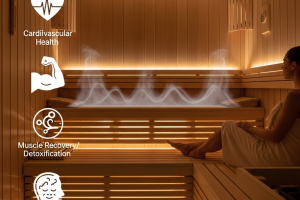The Health Benefits of Sauna: What You Need to Know

The health benefits of sauna have been recognized for centuries, promoting relaxation, detoxification, and improved circulation. Saunas have been an integral part of wellness rituals for centuries, particularly in Scandinavian culture, where they were first introduced as a method for cleansing, relaxation, and improving overall well-being. Today, saunas are enjoyed worldwide for their ability to detoxify the body, ease muscle tension, improve circulation, and provide deep relaxation. But beyond relaxation, scientific studies have revealed that sauna therapy can offer numerous health benefits, making it more than just a luxury.
- The Health Benefits of Sauna: What You Need to Know
- What Is a Sauna?
- What Does a Sauna Do for the Body?
- The Health Benefits of Sauna
- 1. Supports Heart Health
- 2. Reduces Stroke Risk
- 3. Relieves Muscle and Joint Pain
- 4. Boosts Immune Function
- 5. Improves Mental Well-being
- 6. Aids in Weight Management
- Skin Benefits of Sauna
- Who Should Avoid Saunas?
- Safety Tips Before Entering a Sauna
- Types of Saunas
In this article, we’ll explore what a sauna is, its benefits, effects on skin, who should avoid it, safety precautions, and the different types of saunas available.
What Is a Sauna?
A sauna is a specially designed heated room, usually built from wood, where individuals spend a short period of time in high temperatures to induce sweating. Traditional saunas typically maintain temperatures around 90°C (194°F), though modern variations may differ.
The primary goal of sauna bathing is to raise the body’s temperature, leading to increased heart rate, expanded blood vessels, and heavy sweating. This process mimics the effects of moderate exercise, helping the body release toxins and promoting relaxation.

What Does a Sauna Do for the Body?
The effects of a sauna session go far beyond simple relaxation. By temporarily raising the body’s core temperature, saunas activate numerous physiological responses, including:
- Increased blood circulation – The heart pumps faster, delivering more oxygen and nutrients to tissues.
- Detoxification through sweating – Heavy perspiration helps flush out accumulated toxins.
- Pain relief – Muscle and joint pain may be reduced as heat relaxes tight tissues.
- Stress reduction – The calming environment eases tension and promotes mental relaxation.
- Improved sleep quality – Heat therapy can help individuals fall asleep faster and achieve deeper sleep.
- Energy boost – Many users report feeling revitalized after a sauna session.
- Weight management support – Regular sauna use may aid metabolism and support calorie burning.
- Immune system stimulation – Heat exposure encourages white blood cell production, strengthening defenses.
The Health Benefits of Sauna
Saunas are linked to a wide range of physical and mental health benefits. Here are some of the most important advantages:
1. Supports Heart Health
Studies have shown that regular sauna use can improve cardiovascular function. By mimicking the effects of mild exercise, sauna sessions help regulate heart rate and blood pressure. For individuals with mild heart conditions, saunas may support better circulation and cardiac performance.
2. Reduces Stroke Risk
Research suggests that individuals who engage in sauna bathing 4 to 7 times per week may significantly lower their risk of stroke. Improved blood circulation and oxygen delivery play a key role in reducing this risk.
3. Relieves Muscle and Joint Pain
Heat therapy is widely recognized for easing pain. Sauna sessions can be particularly helpful for people recovering from exercise, experiencing arthritis, or dealing with general stiffness. By reducing inflammation and relaxing muscles, pain relief becomes more noticeable.
4. Boosts Immune Function
Exposure to high heat can temporarily raise white blood cell production, which enhances the immune system’s ability to fight off infections. This may explain why regular sauna users often report fewer colds and seasonal illnesses.
5. Improves Mental Well-being
Saunas not only relax the body but also calm the mind. The warmth encourages the release of endorphins, which are natural “feel-good” hormones. Many people find that sauna sessions reduce anxiety, improve mood, and even alleviate mild depression symptoms.
6. Aids in Weight Management
While a sauna is not a replacement for exercise, it can be a supportive tool for weight management. Increased heart rate and sweating help burn additional calories and stimulate the metabolism.
Skin Benefits of Sauna
One of the most noticeable effects of sauna use is its impact on the skin. Heat-induced sweating opens pores, removes impurities, and rejuvenates the complexion. Key skin benefits include:
- Deep cleansing – Sweating flushes dirt, oil, and toxins from pores.
- Enhanced hydration – Improved circulation brings nutrients and moisture to the skin.
- Acne prevention – By removing excess oil, sauna sessions may help reduce breakouts.
- Improved elasticity – Heat promotes collagen production, keeping skin firm and youthful.
- Relief for skin conditions – Some studies suggest sauna use may help reduce symptoms of psoriasis.
However, for individuals with atopic dermatitis or other chronic skin issues, sauna use may worsen symptoms. Consulting a dermatologist is recommended before incorporating sauna therapy.
Who Should Avoid Saunas?
While saunas offer impressive health benefits, they are not safe for everyone. Certain groups should avoid or limit sauna use due to potential health risks:
- People with asthma or chronic respiratory conditions
- Individuals with heart disease or uncontrolled high/low blood pressure
- Those with epilepsy
- Pregnant women
- Children under the age of 7
- People under the influence of alcohol or sedative medications
If you have any chronic illness, it is best to consult with a healthcare professional before using a sauna.
Safety Tips Before Entering a Sauna
To maximize the benefits and avoid risks, follow these simple precautions before your sauna session:
- Stay hydrated by drinking water before and after use.
- Avoid wearing metal jewelry, glasses, or contact lenses.
- Enter with a clean, dry body.
- Use a towel or swimsuit instead of heavy clothing.
- Limit sessions to 15–20 minutes at a time.
- Leave immediately if you experience dizziness, nausea, or headache.
- Avoid bringing electronic devices into the sauna.
By following these safety measures, you can ensure a more pleasant and beneficial sauna experience.
Types of Saunas
There are several types of saunas, each offering unique heating methods and experiences:
- Traditional Finnish Sauna – Heated with wood-burning stoves, featuring high heat and low humidity.
- Electric Sauna – Powered by electric heaters, allowing precise temperature control and convenience.
- Infrared Sauna – Uses infrared light to directly heat the body rather than the air. These saunas operate at lower temperatures, making them more comfortable for some users while still offering similar benefits.
Sauna bathing is far more than just a luxury or spa activity—it is a time-tested wellness practice with scientifically proven health benefits. From supporting heart health and reducing stress to improving skin quality and boosting immunity, saunas can be a powerful tool for overall well-being.
However, it’s essential to approach sauna use responsibly by staying hydrated, respecting time limits, and consulting a doctor if you have underlying health conditions. With proper use, a sauna can become a rejuvenating ritual that enhances both physical health and mental balanc







Teşekkürler, bu bilgi için.